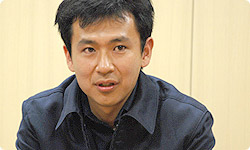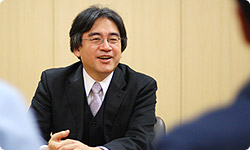3. A Fresh Vision
Morimura-san, thanks for waiting. By the way, you were one of the first members of the “Userbase Expansion Project”11, weren’t you?
11 The Userbase Expansion Project is a project across all the departments in Nintendo which began with the launch of the DS. Members were assembled from a number of development departments and exchanged ideas about software to expand the game playing population.
Yes. At the time I was part of the Entertainment Analysis & Development Division, but in that project there were representatives from all sorts of departments within the company, and there were also people from departments not related to software development, so I learned that there are all kinds of perspectives on the issue.
It was from that project that the original model for “Brain Training” and the key word “Brain Age” emerged. Morimura-san was a member of the team who suggested I consider making Brain Training on the DS. After that, he transferred to the Network Service Development Department, and this is his first project there. How did you first think you would bring it all together?
When I joined this project, the basic model for the Activity Meter was pretty much finished, so I began by thinking about what kind of things we could do with the software using the Activity Meter that they had built.

When you say the Activity Meter, you mean the cartridge design, right?
That’s right. The one that they built first. So I thought I should add some fun ways to play that you don’t find with normal pedometers and which are characteristic of Nintendo. So we got everyone together, thinking up plans and building all kinds of prototypes.
At the time, the Activity Meter didn’t have a name, and it was called by the development code “DHC”. I didn’t know for a long time, but it turns out that DHC is an abbreviation of “DS Hosuukei (Pedometer) Cartridge”. (laughs)
That’s right. The software was going by the working title “Mii Walk”. I thought that Mii characters (characters that resemble you) would work really well with this software. I thought if you could put a Mii on screen as your own double you’d be able to feel a link to your actual lifestyle. As you walk every day, your total step count gradually builds up, and I thought that you should be able to use that to do something fun.
So what kind of things will you be able to do as your step count increases?
For example, as you walk more each day your in-game Mii will be able to go to various places around the world and leave a monument there. This feature is still there in the finished version, and I had thought that this map of the world you build as you walk around could become the centrepiece of the game, but…
It wasn’t the centrepiece.
No, Iwata-san pointed out that just leaving monuments behind on the Earth wouldn’t lead to enough motivation to continue every day. I had quite a lot of trouble trying to find a good solution.
On the other hand, the Activity Meter was just about finished, so I thought for the time being I’d have the board members take home the product as we had it and hear their honest opinions about it.
I was made to take it home. At the end of last year. (laughs) I was told to test play it over the new-year holiday.

We held a conference after the holidays, but the response we got wasn’t all that great. (Shigeru) Miyamoto-san12 said that it wasn’t clear what the software was trying to do.
12 Shigeru Miyamoto is the Senior Managing Director of Nintendo Co. Ltd. He is the creator of Mario.
The response from everyone who had tested it regarding the hardware was very good. But they said that we should be able to do something more with the software. I think that the “world map” that Morimura-san had been thinking of as the centrepiece is also one part of the fun of the game. As a game for a pedometer it is visual and elegant. But, it is a bit limited to have as the centrepiece. I just couldn’t think that I’d want to keep going at it every day just to progress round the planet. So I thought that, with the game like this, most people wouldn’t keep going every day.
If I think about it now, at the time I was still trapped by thinking within the boundaries of existing pedometers. The original base for the plan was to make a fun game with a pedometer and I was thinking that as you walk more, your step count builds up and as a result you should be able to do something fun.
That’s why we were calling it Mii Walk. Your Mii would walk around, building up a high step count and then be able to get a reward.
But most people aren’t thinking that they want to walk around a lot.
Right. If there wasn’t something about it that could hold the attention of people who aren’t interested in walking a lot then this game wouldn’t spread very far. So, when was it that Mizuki came to join the project?
It was right at the time of that conference with the not so great response. I was present there, and listening to everyone’s responses. There was some really harsh feedback…

Did it really feel that harsh? (laughs)
Just a little. (laughs) So then I thought about what I’d be able to do, and as soon as the conference had finished I went over to Shimomura-san and told him that I wanted to help.
Mizuki-san is really just like a relief pitcher.
A relief pitcher? Like in baseball?
That’s right. The starting pitcher, Morimura-san was facing a big pinch after taking some big hits from the board members, and unable to bear it, he calls for the relief pitcher.
(laughs)
Well that’s just about how I came to join the project. (laughs)
So then, Mizuki, you come in and provide the relief and what is the first thing that you do?
First I asked the members of my own group to have a play with it and did some refinement with those opinions as reference. At the same time as that was moving forward, I thought about whether there was a way to use the step data per minute that Shimomura-san had proposed. Iwata-san spoke to me about this feature a number of times.
I felt that the first thing I wanted to see when I got home and sent my Activity Meter data to my DS was the step data for each minute. But with the prototype I took home over New Year, it was buried deep into the menu, as if it was being treated just as a bonus feature.
At the time it wasn’t in the specifications for you to be able to see it straight away. But, in February the Tokyo marathon was being held, and as one of our staff members was participating in it and, partly as a test, we had him run with the Activity Meter. Then when we looked at the per minute data after the race it was really interesting. At that time we already had the data displayed as a bar chart, and we could see that there was a gap of about 5 minutes there. Everyone got excited, saying “Ah here’s where he went to the toilet”.

Also, the number of steps per minute would change according to your running speed, so I’m sure it was interesting to be able to see how you ran afterwards.
Some people would get tired and sometimes stop, and because that period of time comes up blank you find out exactly when you were resting and for how long. So thanks to the Tokyo marathon, we decided to strengthen the per minute data recording section, for example making it possible to add memos to the data.
Well, that may be fun for the kind of people who can compete in the Tokyo marathon, but isn’t that a rather limited number of people?
If you are living a normal regular lifestyle, a similar pattern will be recorded every day, so it might feel a bit mundane or lose its freshness.
Unless there is a special event, it will feel like every day is just the same thing.
That point became a real key issue for us, and I had a number of discussions about it with Morimura-san.
So, Morimura-san, when was it that you came to see the light?
It was when I was riding on the train. I had gone with Mizuki-san to have a meeting with the development company and late at night on the train back to Kyoto when I was talking to Mizuki-san…
You hear a lot nowadays about so-called “lifestyle-related diseases”. Let’s say , for example, that you hardly walk at all on Sunday morning. When you look at the per minute data it would be clear as day that your activity levels were low.
And so we thought that it might be pretty good if we made it into a game that measured your lifestyle, and we both got really excited.

You saw the light when you were on the late night train. (laughs)
So the next morning we went straight to discuss it with Shimomura-san, he got it right away and said “Maybe we could call that ‘life rhythm’”.
So it was Shimomura-san who thought of the keyword “life rhythm”. I thought it had a nice ring to it from the first time I heard it too.
I’m normally told that the suggestions I come up with are no good, and they get rejected. (laughs)
To have a good life rhythm can also mean that you have a regular lifestyle. That’s why I thought that if a similar pattern of data is recorded every day, you can think of it not as being “Ah, today was just more of the same”, but instead take it in a positive way thinking “Ah, I had a good life rhythm today.”
Before that we had only looked at the per minute data at the level of a single day. But, when we made it so you could compare per week, per month or for a certain day of the week we were able to see something we couldn’t before.
For example, when I looked back at the level of two or three months, in my case the number of steps in August was quite large. I was able to praise myself for doing a lot of exercise over the Obon holiday.
For me, after we entered the final stages of development, the time I was arriving back home was getting later and later each day. So when I looked back at the data for my weekly levels, the period during which I was making it home later was clearly visible in the step data. Seeing this almost made me glad I was doing overtime. (laughs)
(laughs)
Even within my own lifestyle I became able to see things I couldn’t before and truly felt that this could really work.
